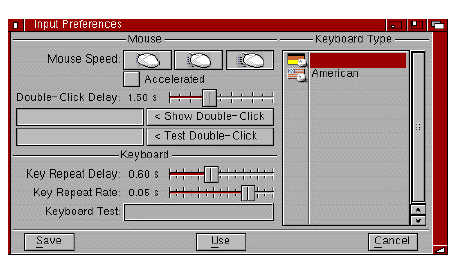
The Input editor allows you to change the speed at which the mouse and keyboard operate and to select your keyboard type. Figure 5-3 illustrates the Input-Preferences editor window.

Input Preferences Editor Window

The Mouse Speed slider determines how fast the mouse pointer moves across the screen relative to mouse movement. The faster the pointer moves across the screen, the less surface space and effort is needed to move the mouse.
Choose from three mouse pointer speeds: 1, 2, and 3, where 1 is the slowest and 3 is the fastest. Set the mouse pointer speed by dragging the slider bar until the desired value is displayed. The mouse speed takes effect while you set it, allowing you to try each speed without exiting the editor. The default value is 3.

The Acceleration feature is used for moving the pointer quickly over large screen areas while retaining fine control for smaller movements. If acceleration is on, the pointer speed remains constant within a small area. However, as the pointer is moved further across the screen, its speed increases, moving it quickly over a large area of the screen.
Select the check box to turn acceleration on or off. The default value is off.

The Double-Click Delay slider determines how fast you click the selection button to register a double-click.
The range is from 1 to 200, with 1 being the least delay. The Show Double-Click gadget shows the amount of time for the selected value by displaying shading in the gadget for the length of the delay. The default value is 75, which allows approximately one second between clicks.
Test your chosen speed by double-clicking in the Test Double-Click gadget. When the double-click takes place within the allotted time, a Double-Clicked message appears next to the gadget; if not, a Too Slow message appears.

Most of the keys on the keyboard automatically repeat when held down. Change the delay that occurs before the key repeats with the Key Repeat Delay slider.
The current setting is shown next to the slider. The range is from 1 to 75, with 1 being the least delay. Drag the slider bar to the right to increase the delay and to the left to decrease it. The default value is 30.

The Key Repeat Rate slider determines the rate at which the keys repeat after the initial key repeat delay.
The range is from 1 to 125, where 1 is the slowest. Drag the slider bar to the right to increase the speed and to the left to decrease it. The default value is 100.

The Keyboard Test gadget allows you to test the settings chosen for the key repeat delay, the key repeat rate, and the keyboard type.
Select the gadget and hold down one of the alphabetic keys on the keyboard. The Keyboard Test gadget shows the character for that key in the selected keyboard type, repeating according to the current key delay and key repeat rate.

The Keyboard Type list lets you select the appropriate keyboard type for your localized system. The correct keyboard type matches the characters printed on your keyboard's keys and gives you quick access to the special characters that are part of your language and locale. If you are using a keyboard other than USA, you can use dead keys to produce accented characters. See the KeyShow description in Chapter 10 for dead key information.
|
If your keyboard type is not the default American, you must activate your appropriate keymap/keyboard. Consult your dealer if you are not sure which keymap/keyboard you should use. |
Choosing a particular keyboard type activates the corresponding keymap file in the Devs/Keymaps drawer. Select your keyboard type in the Input Preferences editor by clicking on it.
The available keymaps and the corresponding keyboards are:
If your keyboard type does not appear in the Keyboard Type list, it means that the corresponding keymap is not present in the Devs/Keymaps drawer. Install the corresponding keymap to correct this using the following steps:
Then this is complete, you can return to the Input Preferences editor to activate your keyboard type. To check your keyboard layout, use the KeyShow program in the Tools drawer. For more information about KeyShow, see Chapter 10.
